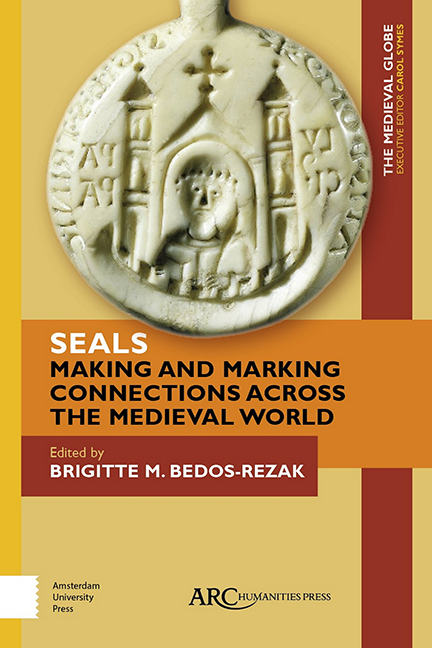Book contents
- Frontmatter
- Contents
- List of Illustrations
- Acknowledgements
- Cultural Transactions: An Introduction to Medieval Seals from a Global Perspective
- Seals as Conceptual and Ritual Tools in Chinese Buddhism, ca. 600– 1000 CE
- Imprinting Powers: The Astrological Seal and Its Doctrinal Meanings in the Latin West
- A Medieval Solution to an Early Modern Problem? The Royal Animal Seals of Jambi
- Expressing New Rule: Seals from Early Islamic Egypt and Syria, 600– 800 CE
- The Formulation of Urban Identity on Byzantine Seals
- The Cloth Seal: A Mark of Quality, Identification, or Taxation?
- Archaeology and Sigillography in Northern Europe
- Medieval Treaties and the Diplomatic Aesthetic
- Index
Expressing New Rule: Seals from Early Islamic Egypt and Syria, 600– 800 CE
Published online by Cambridge University Press: 20 November 2020
- Frontmatter
- Contents
- List of Illustrations
- Acknowledgements
- Cultural Transactions: An Introduction to Medieval Seals from a Global Perspective
- Seals as Conceptual and Ritual Tools in Chinese Buddhism, ca. 600– 1000 CE
- Imprinting Powers: The Astrological Seal and Its Doctrinal Meanings in the Latin West
- A Medieval Solution to an Early Modern Problem? The Royal Animal Seals of Jambi
- Expressing New Rule: Seals from Early Islamic Egypt and Syria, 600– 800 CE
- The Formulation of Urban Identity on Byzantine Seals
- The Cloth Seal: A Mark of Quality, Identification, or Taxation?
- Archaeology and Sigillography in Northern Europe
- Medieval Treaties and the Diplomatic Aesthetic
- Index
Summary
THE GREAT ARAB conquests of the seventh century CE brought the former Romano-Byzantine provinces of Syria and Egypt, along with the whole Sasanian Empire, under Muslim control. Contacts between Arabia and these regions had already been intensive in the pre-Islamic period, resulting in the continuous exchange of knowledge, customs, and administrative practices. Influence and imitation did not simply flow in one direction; they were generative processes, in which forms and ideas were actively adapted to new political, religious, and cultural contexts. The practices and ideas that the Arabs brought to these conquered areas were similarly transformed through interaction with local models and customs, and in close relation to socio-political developments at the provincial and empire-wide level. These processes of exchange and adaptation reflect the political and social transitions set in motion by the Muslim conquests, which found expression in administrative systems, material culture, and religious-intellectual life— processes manifested in the seals used in official and private contexts. Seals continued to exhibit Byzantine, Sassanid, and Arabian habits, but their use and form also reflect the influence of developments under Islam. By comparing early Islamic examples with pre-Islamic ones, and by tracing the developments that occurred over time, I will explore the continuities and changes in usage, imagery, and linguistic expression in order to show how these can be linked to the underlying ideologies and ambitions of Muslim authorities. In particular, I will examine how and why different practices unfolded in Egypt and the Levant, and I will compare these to the dissemination of shared forms throughout the Muslim empire, particularly the rich material from Khurasan in the east and al-Andalus in the west.
Near Eastern Seals and Sealing Practices before and after Islam
The function and meaning of seals in the Near East, widespread from their first introduction in the ancient empires of Mesopotamia, did not fundamentally change in the thousands of years they were in use. By the late antique period impression and stamp seal matrices, mounted in rings or in conical form suspended from strings, had become ubiquitous. By pressing the seal into wet clay, wax, or another mouldable material, an imprint was pressed directly into or fastened onto the object to be sealed.
- Type
- Chapter
- Information
- Publisher: Amsterdam University PressPrint publication year: 2019



